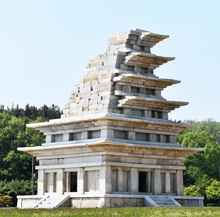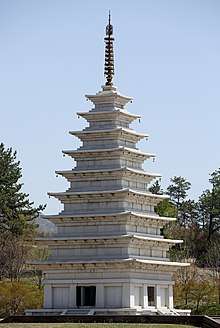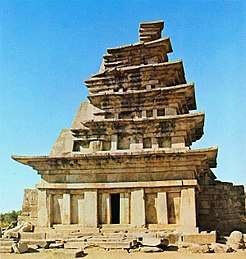Mireuksaji Stone Pagoda
Iksan Mireuksaji Stone Pagoda (Korean: 익산 미륵사지 석탑, Chinese: 益山 彌勒寺址 石塔) is located in Mireuksaji, Geumma-myeon, Iksan-si, Jeollabuk-do, and is the oldest stone pagoda remaining in Korea and designated as the 11th national treasure.[1][2]
| Mireuksaji Stone Pagoda 益山 彌勒寺址 石塔 | |
|---|---|
미륵사지석탑 | |
 Iksan Mireuksaji Stone Pagoda after restoration | |
| Location | |
| Location | Kiyang-ri, Geumma-myeon, Iksan, North Jeolla Province |
| Country | South Korea |
| Architecture | |
| Founder | King Mu of Baekje |
| Completed | 600~640 |
| Website | |
| http://iksan.museum.go.kr/ | |
Iksan Mireuksaji Stone Pagoda (Iksan Mireuksaji Seoktap)
This stone pagoda, built in 639 during the reign of King Mu[3], is called the primitive style(始原形式) of Baekje pagoda, and in many ways it is the starting point of the entire pagoda in Korea[3]. At the time of dismantling, the height was 14.2m, which is the largest stone pagoda in Korea, and is estimated to be 9 stories originally based on extant materials. This stone pagoda realized the wooden pagoda architecture in stone and reflects the appearance and style of Baekje wooden pagoda.[3][4]
History and Characteristics

In 639, the site of Mireuksa was built during the late Baekje. It is the oldest and largest remaining stone pagoda in Korea. It is an important cultural property that faithfully shows the process of transitioning from wooden tower to stone pagoda.[5][2]
This stone pagoda is called the primitive style of Baekje Stone Pagoda. In many ways, it is considered to be the starting point of the whole Korean pagoda. This stone pagoda with granite is unlike the Silla style pagoda. It is a pile of multi-storied pagoda of three sides in the base of a square partitioned by a gravel stone.[5][2]
Most of the western side and the southern side, and about half of the northern side are collapsed, and the number of floors is only up to 6th floor. Currently, restoration is in progress.[6] The extensive restoration process will remove the concrete support applied on the tower during Japanese colonization.
The complete reconstruction of the long-gone East Pagoda, another stone pagoda which once stood at Mireuksa alongside the remaining stone pagoda(also called the West Pagoda), was finished in 1993 based on its counterpart's architecture. The reconstruction began in 1991 under the supervision of the Cultural Properties Bureau at the time of the Roh Tae Woo administration. The stone pagoda of Mireuksaji was once claimed to have had 7 floors originally, but during restoration, a supplementary material was found to indicate that the pagoda had 9 floors.[6][2] The East Pagoda was rebuilt to have 9 floors accordingly and completed in 1993. However, the legitimacy of the reconstruction is still in dispute.
Structure
The short, single-stepped base of the pagoda is similar to the style of a wooden pagoda. The body of the pagoda was divided into three spaces on each side of the first floor, and a door was made in the middle of the room. Inside the center is a huge square pillar. On the first floor, four pillars were erected on each corner which demonstrate entasis, also used in Korean wooden architecture, featuring a narrow top and bottom in contrast to a convex center. On the pillars, pyeongbang and changbang were installed, which are the components that connect two pillars in wooden architecture. The roof slope is thin and wide, and it is raised up to four corners and raised slightly. From the second floor, the top becomes shallow, the expression of each part is simplified, and the roof is also reduced in width than the first floor.[5][2]
Restoration

In 1915, it was repaired with cement to prevent the collapse of the tower during Japanese colonial period. However, in April 1994, the government decided to repair the damaged part because it was not beautiful and there was a risk of collapse.[5][7]
Jeollabuk-do completed the basic process from 1998 to 2000, with the preparation for the repair of the Mireuksaji stone pagoda. Since October 2001, the National Institute of Cultural Properties has begun full-scale maintenance.[8][7]
The repair work for Mireuksaji stone pagoda was planned to be completed in 2007. However, due to the fact that it is the largest stone pagoda in East Asia and it is a national treasure, the schedule was delayed and delayed until 2017.[9][7]
The Cultural Heritage Administration will restore the first and second floors completely symmetrically, and restructure the third and sixth floors before the dismantling. Members of local governments and some experts argue that the tower must be fully symmetrically restored to the fifth floor to prevent its retention and collapse.[10][11]
Excavation

On January 14, 2009, the National Cultural Properties Research Institute of the Cultural Heritage Administration rehabilitated and restored the stone pagoda of Mireuksa Temple in Iksan. At that time, he found a martial art in the center of the upper surface of the pillar, named Sarijangeom (sarijang-eom, 사리장엄, 舍利莊嚴).[7][2][12]
They found a small bottle with a height of 13cm and a shoulder width of 7.7cm. As a result of inspecting the inside with X-ray, it was confirmed that it is composed of a double structure of inner and outer box. The variety of patterns and handwork techniques on the surface of Sariho show the excellence of Baekje Metal Craft.[7][2][12]
They also found the golden Saribongangi (sari-bong-an-gi, 사리봉안기, 舍利奉安記). The Saribongangi was engraved on the gold plate of 15.5cm in width and 10.5cm in height and painted red to make it clearly visible. It is written that Queen Baekje donated riches and founded a temple and prayed for the good of the royal family by sealing the Sari in the year of 639. It is evaluated as a precious stone statue material which can complement the lack of research of literature by precisely establishing the purpose of the founding of Mireuksa, It was more notable that there was a difference from the record of Samguk-Yusa, in which the Queen was recorded as the daughter of "Sa", one of the eight nobles of Baekje, and that Princess Sunwha had created Mireuksa Temple.[13][2][12]
The inscription, in the original Classical Chinese, reads:
|
|
Roughly translated into English, this becomes,
Coming to think of this, the Buddha (法王) came to this world in synchronisation with and response to the will of the many disciples of Buddhism, and this is like the moon shining in water. Thus the Buddha was born into a palace and achieved Nirvana under a sal tree, leaving behind eight pieces of sarira, benefiting three thousand worlds. So surely, if the sarira, which shines in five colours, were to be turned seven times in respectful rite, the resultant divine transformation would be indescribable. Our Queen of Baekje, (one of King Mu's Queen Consorts) as the daughter of Jwapyeong (佐平) Sataek Jeokdeok, (沙乇積德) planted benevolence through the ages, and with the karma she has received in her present life, she educated the people. She, being a great supporter of the Buddha's teachings, established temples with her wealth and received this sarira on the twenty-ninth day of the first month of the Gihae year. (March 9, 639 AD according to the Julian calendar) We pray, through the charity of ages and founding upon this act of benevolence, that the longevity of His Imperial Majesty (King Mu; 大王陛下) should stand firm like the mountains and that his reign should be eternal with the heavens and the earth. We pray for the spread of the Righteous Way (正法) above, and the flourishing of all people (蒼生) below. We pray again that the body and heart of the Queen become like a water-mirror, ever reflecting Dharma. Let her precious body never perish as with the skies, and give her happiness unto many generations, and let all Buddhist followers achieve Enlightenment.
References
- "East stone pagoda in Mireuksa temple site". Unesco. Retrieved 2018-06-21.
- "국보 제11호 익산 미륵사지 석탑 (益山 彌勒寺址 石塔)" [Mireuksaji Stone Pagoda]. KOREA CULTURAL HERITAGE ADMINISTRATION. Retrieved 2018-06-21.
- 이, 영란 (2009-01-19). "익산 미륵사 백제왕후가 지었다" [Iksan Mireuksa Paekje was the king.]. Herald (in Korean). Retrieved 2018-05-14.
- 김, 경빈 (2018-02-04). "17년 만에 재탄생, 미륵사지 석탑" [Rebirth in 17 years, Mireuksaji Stone Pagoda]. 중앙SUNDAY (in Korean). Retrieved 2018-06-18.
- "미륵사지 석탑" [Mireuksaji Stone Pagoda]. rinks.aks.ac.kr (in Korean). Retrieved 2018-06-21.
- kim, dong-chul. "The stone pagoda of Mireuksaji Iksan which is reborn ... 26 days Restoration start ceremony". Yonhap News. Retrieved November 21, 2013.
- 송고, 시간 (2018-06-20). "콘크리트 걷어낸 익산 미륵사지 석탑, 20년 대역사 마무리(종합)" [Ik-san Mireuksaji Stone Pagoda, which has been made of concrete, finished in 20 years]. yonhapnews.
- 김진형 (2018-06-20). "미륵사지 석탑, 20년 만에 '일제 땜질' 벗었다…웅장한 모습" [Mileuksajji stone tower, 20 years after the 'tile soldering' took off ... Magnificent appearance]. SBS.
- "<현장클릭> 익산 미륵사지석탑 보수 162일간의 현장 석탑해체 공정 80% 진행 중" [Repaired Stone Pagoda in Iksan Mireuk Temple Site]. dailyan. 2008-07-10.
- 김, 진만 (2014-11-24). ""미륵사지 석탑 비대칭 복원 문제 있다"" ["There is an asymmetrical restoration of the Stone Pagoda of Mireuk Temple Site"]. Jeonbuk Daily.
- 정, 진명 (2015-05-28). "완전 복원이냐, 부분 복원이냐..'미륵사지 석탑' 시끌" [The stone pagoda of Mireuk Temple Site]. jtbc.
- 이, 은주 (2018-06-20). "백제의 유산 익산 미륵사지 석탑, 20년 만에 수리 마쳤다" [The heritage of Baekjae was completed in 20 years after the stone pagoda of Mireuksa Temple in Iksan]. jtbc.
- 이, 민정 (2009-01-19). "미륵사 석탑속에 유물 잔뜩‥"백제지역 최대 고고학적 성과"" [The Stone Pagoda of Mireuk Temple is filled with relics.]. newsis.